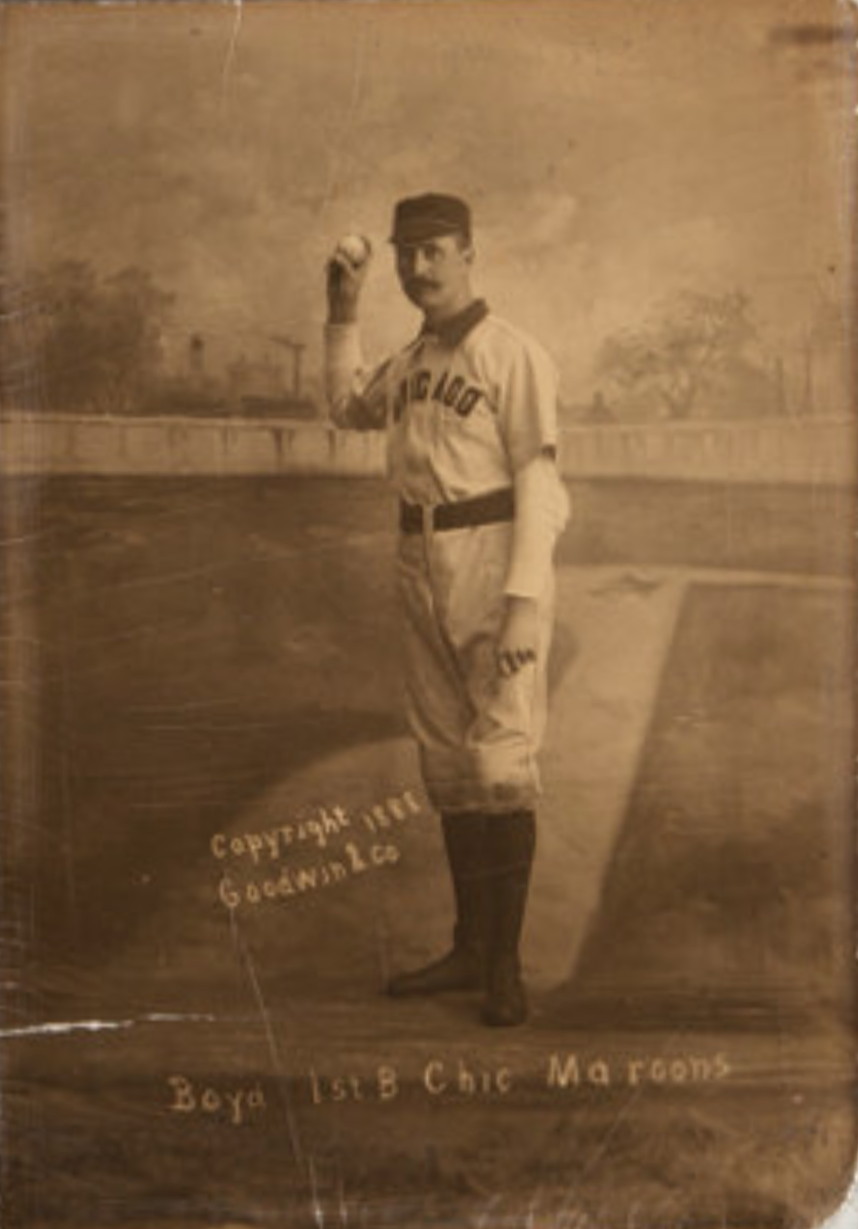C. N. Boyd

Image from Old Judge card set | C. N. Boyd
Born: January 18, 1861
Died: June 7, 1934
Goto Baseball Reference for C. N. Boyd | ss | Majors:
No |
|
Chicago
Position: ss
First game: DNP
Last game:
# of games: 0 | The Chicago Inter Ocean reported on March 4, 1888, "Charles Boyd, of Sheffield, Ill, has been signed by the Chicago Maroons to play short stop. He is large and heavy, and is a sprinter and batsman." His last mention in the Chicago papers was April 11, 1888 in the Chicago Daily News. Boyd later briefly played for Danville in 1888 (St. Louis Globe-Democrat, June 10, 1888, pg 10). The identification as "Charles" in the Chicago papers is incorrect. 
|
In February 1888, the Sporting News reported that the Chicago Maroons "filled their only vacant position by signing Chas. Boyd of Sheffield, Ill., to play at short field. He is a large man over six foot in height, and a sprinter of considerable note" (February 18, 1888). Maroons manager Sam Morton claimed Boyd could beat Billy Sunday in a hundred yard race. (Sunday was considered one of the fastest ball players at the time.) The Chicago Inter Ocean proclaimed "He is large and heavy, and is a sprinter and a batsman" (Macrh 4, 1888). The Chicago Daily News wisely noted "Boyd, the short-stop, is a new man, having never played professionally, and, consequently, his bright future yet lies before him the same as that of everybody else" (April 11, 1888). His future may have been bright, but it wasn't with the Maroons. That was the last time he was noted in the Chicago papers. He didn't appear in any spring training games, and there was no mention of his release. Had he not been photographed for the Old Judge tobacco cards released in 1888, one might never have known that Charles Boyd played professional baseball.
 Technically speaking, Charles Boyd didn't play professional baseball; the newspapers got the name wrong. The player signed by the Maroons in February 1888 was most likely Commmodore Nathaniel Boyd, of Sheffield, Illinois.
Technically speaking, Charles Boyd didn't play professional baseball; the newspapers got the name wrong. The player signed by the Maroons in February 1888 was most likely Commmodore Nathaniel Boyd, of Sheffield, Illinois.
In 1887, the Champaign Clippers signed C.N. Boyd, "an old University boy" to play second base and catch (Champaign County Herald, August 1, 1887). C.N. never joined the club due to his father's illness. However, that "University boy" played for the University of Illinois in 1880 and 1881, and was a member of the Class of '81 (1881, that is). He was identified in an alumni directory from 1907 as Comma Nathaniel Boyd. While at the University of Illinois, he organized the first baseball team for the school and was manager and captain for two years.
Occasional updates in the Champaign papers indicated Boyd was farming in Sheffield, Illinois, and in 1885 the Daily Illini reported that he was playing ball in Sheffield. The Champaign Daily Gazette reported on April 11, 1888 that "Boyd has been afflicted with a sore throat for several days." Assuming that this refers to C.N. Boyd (and given his affiliation with the University, this is reasonable), it is possible this untimely illness prevented him from joing the Maroons.
Boyd played briefly for Danville in 1888 after his release from the Maroons, for about two weeks in June (St. Louis Globe-Democrat, June 10, 1888 and June 21, 1888). That was the extent of his professional career. A player named Boyd (incorrectly identified as Botd by Baseball-Reference) played for Leavenworth in 1886; there is no definative connection to C.N. Boyd.
Commadore Boyd was the son of Nathaniel and Mary (Cummings) Boyd. He was born on January 18, 1861. His grandfather, Charles S. Boyd, was an early settler in Illinois. In 1890, Commadore married Addie Humphries. They had five children, one of who died as an infant, by 1900, when they were farming in Concord township. He remained active in athletics throughout his life. In 1924, he was recognized by the University of Illinois at the dedication of the new Illinois Memorial stadium with a letter for his athletic accomplishments.
He died in Kewanee, Illinois on June 9, 1934, at the age of 73, as a result of injuries suffered in a fall ten days prior at his home. He was burried in the Sheffield Cemetery.

 Technically speaking, Charles Boyd didn't play professional baseball; the newspapers got the name wrong. The player signed by the Maroons in February 1888 was most likely Commmodore Nathaniel Boyd, of Sheffield, Illinois.
Technically speaking, Charles Boyd didn't play professional baseball; the newspapers got the name wrong. The player signed by the Maroons in February 1888 was most likely Commmodore Nathaniel Boyd, of Sheffield, Illinois.